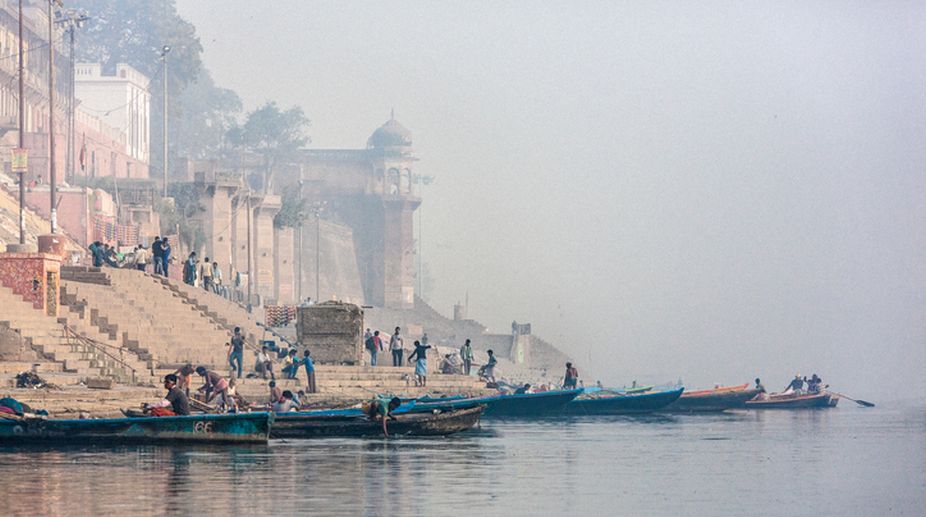The Ganga, regarded as the cradle of India’s civilisation, has been gradually sinking and stinking. It is choked with dangerous chemicals and organic waste that are emptied into the waters every day. Known as the Stream of Nectar, the Ganga as the legend goes was initially hesitant to come down to earth since she thought that people would wash their sins in its bosom. Today, the river’s worst fears appear to have been confirmed. Having the largest river basin of about 1,080,000 sq. km, covering about 26 per cent of India’s land mass and carrying 25 per cent of the water wealth, the Ganga is in a miserable condition. It is estimated to be 2,525-km in length, ranging from the Gangotri in the Himalayas to the Ganga Sagar. The worst polluted stretch is almost 600 km long.
Historically, the Ganga has played a unique role. Although great cities, civilisations and empires have risen on the banks of several rivers of the world, the Ganga has come to be regarded as the holiest and most venerated river on earth, not only by the people living along its banks, but also by Hindus living in other parts of this country and abroad.
Some of the scriptures and works of even non-Hindus mention the Ganga as the best of all rivers. Mughal emperors, besides other Muslim kings before and after them, would only drink Ganga water. Over time, therefore, the river has played a crucial role in terms of national integration.
Megasthenese, who visited India in the fourth century BC as ambassador to the court of Chandragupta Maurya, has written that Indians worshipped the rain-god Zeus (Indra), the Ganga river and local deities. It is obvious that the Ganga must have been regarded as a holy river for quite some time before his visit. The Mahabharata (200 BC- 400 AD) and the Vishnu Purana (C. 200 AD) are perhaps the first Indian books to sing paeans to the Ganga and its water.
One major reason for the Ganga’s importance is the unique quality of its water. One of the earliest references to the extraordinary properties of Ganga water is found in the Mahabharata and its words ~ “white like milk…’’. The great epic narrates: “If after death, the bones of the dead are deposited in the Ganga the departed will attain heaven. Even one who sinned throughout his life would attain Vishnupada (heaven) if he worshipped the Ganga. Bathing in the Ganga is as beneficial as performing a hundred yajnas. All the sins of those on whom has blown the air which had come in contact with Ganga water can wash off all sins and purify mortals’’.
The deificaton of the Ganga was completed in the Puranas ~ “The offences of any person who bathes in this river are immediately expiated and unprecedented virtue is engendered. This sacred stream, heard of, desired, seen, touched, bathed in, or hymned, day by day, sanctifies all beings’’. The Bhagvat Purana (circa 6th c. AD), after giving an account of the descent of the Ganga from heaven to earth says: “What then may be the glorious end of those who keeping to the rules of austerity, worship with devotion Ganga Devi, by the very touch of whose waters, the sons of Sagara went to heaven in their bodies burnt to ashes long ago.’’
The Ain-e-Akbari has referred to the Ganga. Abul Fazl wrote: “His majesy calls this source of life ‘the water of immortality’, and has committed the care of this department to proper persons. Both at home and on travels he drinks Ganga water.’’
The Flemish philologist and naturalist, Joannes de Laet, in his account of India during Jahangir’s reign states that “the water of the Ganga is considered the most pleasant and wholesome, hence the emperor has this brought to him in bottles wherever he goes and drinks it alone.’’ (De Imperio Magni Magolis , first published in 1631). Apart from rapid industrialisation, a booming population and disproportionate development, many social factors have contaminated the holy river.
The sources of pollution are urban liquid wastes, industrial liquid wastes, large scale wallowing of cattle and dumping of the dead into the water. In addition, the increasing surface run-off from cultivated land on which pesticides are used and a similar run-off from the grounds where urban solid wastes and industrial wastes are dumped, are also responsible. The ‘cultural factor’ ‘in polluting the Ganga is witnessed especially during Kumbh Mela and other such auspicious occasions, when millions of people take the holy bath.
As Prime Minister, Indira Gandhi had wanted the Ganga to be cleaned up. Towards that end, she had approved an action plan and had even suggested the setting up of an authority to implement the plan. Rajiv Gandhi made the plan public in his first broadcast to the nation. The Ganga Action Plan was launched by the Government of India in 1985 and in 1986 the National River Basin Authority was constituted.
GAP II was initiated in 1993. The National River Conservation Plan came into effect in 1995. It was in 2008 that the Ganga was declared India’s National River. The National Mission for Clean Ganga was formed in 2011. Operation Ganga is said to be the biggest such endeavour in the world.
An ambitious deadline has been set for 2018. But the challenges mentioned in the latest CAG report are no less serious. The CAG has been critical of the National Mission for Clean Ganga for failing to spend a major portion of the amount earmarked for the project. The report is a clear indictment of the statutory authorities.
In 2014, the Supreme Court in MC Mehta vs Union of india and others on pollution in the Ganga had highlighted the mismanagement of funds. In addition, there are problems relating to land aquisition; even sewage treatment plants are being delayed. This is a noble mission and deserves the best action in the follow-through.
The writer is former Associate Professor, Department of English, Gurudas College in Kolkata











